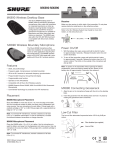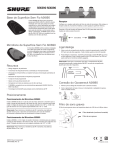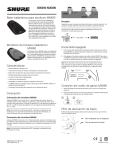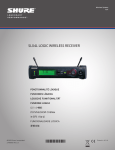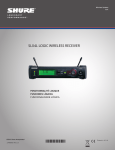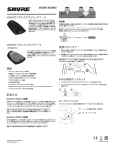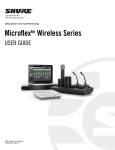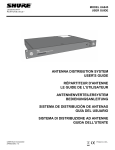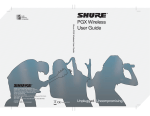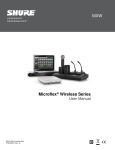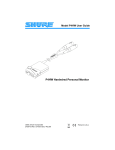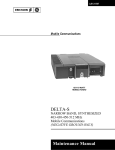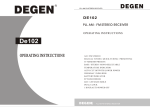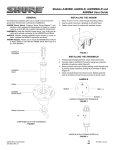Download Shure MX890 User Guide (English)
Transcript
Model MX890 Wireless Desktop Base The Shure MX890 desktop base for MX405 and MX410 gooseneck microphones offers cable-free installation for corporate boardrooms or other applications requiring flexible microphone configurations. The MX890 operates within the 518–865 MHz bands and is compatible with Shure SLX wireless systems. ©2008 Shure Incorporated 27EN3253 (Rev. 3) Printed in U.S.A. Features • Sleek, low profile design • Frequency agile, microprocessor controlled transmitter • IR link to SLX receiver for automatic frequency synchronization • Programmable frequency Group/Channel display • Programmable mute function • Operates on two AA batteries • Compatible with all Shure SLX Wireless systems • Supports Shure MX405 and MX410 Mini Gooseneck Microphones • Commshield™ technology for protection from RF interference 2 Microphone Placement Place the MX890 no more than 25 cm (1 ft.) from the edge of the table. Aim the microphone toward the talker and away from loudspeakers and noise sources. Use one microphone for each talker. Pickup angle with a cardioid cartridge is 130° at –3 dB. Pickup angle with a supercardioid cartridge is 115° at –3 dB. Note: To minimize RF interference, maintain a distance of at least 0.3 m (1 ft.) between transmitters. In case of interference, increase the distance between transmitters or change channels. 130º Receiver Make sure the receiver is within sight of the transmitter. Do not place receiver behind a metal barrier or any reflective surface. Refer to the SLX Wireless System User Guide for more information, or visit www.shure.com. 30m (100ft) 3 Connecting Gooseneck 1. Align the pin on the microphone flange with the slot on the desktop base. 2. Insert the gooseneck into the desktop base and lock it in place by rotating the gooseneck sleeve clockwise. Low-Cut Filter The low-cut filter attenuates frequencies below 150 Hz by 6 dB per octave. Filter disabled (as supplied) Low-cut filter 4 Battery Installation 1. Open the battery compartment as shown. 2. Insert two1.5V “AA” batteries. Make sure the +/– terminals are properly oriented. Note: Alkaline batteries last up to 8 hours. Rechargeable, carbonzinc and zinc-chloride batteries provide less operating time. Power Meter The battery meter on the LCD shows remaining battery life. Low Power Indicator Steady Red: Power low. Replace batteries immediately Pulsing Red: Batteries dead. Transmitter cannot be turned on until batteries are replaced. 5 Power On/Off 1. Press and hold the ON/OFF PROGRAM button for approximately 2 seconds. The LCD illuminates. 2. To turn the transmitter off, press and hold the ON/OFF PROGRAM button again. Note: Use the button on the bottom of the transmitter to power it on without opening the battery compartment. 6 Mute Button The mute button can be configured for toggle or momentary operation. Toggle (as supplied) The PUSH button toggles the microphone between active and muted states. NOTE: The microphone always powers up in the active state. Momentary There are two types of momentary operation: Push-to-Mute: The microphone is muted only while the button is pressed and held. Push-to-Talk: The microphone is active only while the button is pressed and held. To change between toggle and momentary: Hold the PUSH button and Hold press the SELECT button. (Test the microphone to confirm the change.) To change between push-to-talk and push-to-mute: 1. Set the button for momentary operation. Hold 2. Hold the SELECT button and press the PUSH button. 7 Mute Indicator The desktop base illuminates the gooseneck microphone LED to indicate whether the microphone is active or muted. Refer to the following table: Microphone Status MX405 / MX410 Indicator MX405R / MX410R Light Ring Active Green Red Muted Red/Flashing Green* Off/Flashing* *To toggle between off and flashing, press PUSH and ON/OFF PROGRAM simultaneously. + 8 Locking Settings Press ON/OFF PROGRAM and SELECT simultaneously to lock or unlock transmitter settings. When locked, the current settings cannot be manually changed. Note: Locking the transmitter settings does not disable IR frequency synchronization or the High Pass/Low Cut filter. LOGIC MODE To use with a logic enabled receiver, you must perform an automatic sync. The LCD flashes “log” during sync. Once in logic mode, the LCD flashes “log” when powered up. 9 Automatic Frequency Synchronization 1. Power off all transmitters. 2. Power on all receivers. 3. Begin with the first transmitter. Open the battery cover and power it on. 4. Aim the IR sensor at the first receiver IR port. The transmitter should be no more than 15 cm (6 in.) from the receiver. Press and hold the receiver SYNC button to send group and channel data to the transmitter. The red LED on the transmitter will stop flashing when programming is complete. 5. Power off the first transmitter and repeat the synchronization with each additional transmitter and receiver pair. Manual Frequency Synchronization 1. Press and hold the transmitter SELECT button until the desired group number appears. 2. Press SELECT again and release it when the desired channel number appears. 10 Tips for Optimum Performance • Maintain a direct line of sight between the transmitter and receiver antennas. • Avoid placing the transmitter on metal surfaces. • Avoid placing laptop computers or other obstructions in front of the microphone during use. • Only use with a Shure SLX4 wireless receiver. Troubleshooting If you encounter difficulty with the SLX Wireless System: • Make sure both the transmitter and the receiver are turned on. • Replace the battery if the battery LED is red. • Make sure the Group/Channel settings for each transmitterreceiver pair are identical. • Make sure there is an unobstructed line of sight between the transmitter and receiver. • If necessary, reposition the receiver or decrease the distance between transmitter and receiver. • Remove local sources of RF interference, such as computers or lighting equipment. • Remove metal objects within 0.3 m (1 ft.) of the transmitter Note: Refer to the SLX Wireless System User Guide for complete troubleshooting procedures. 11 Frequency Selection Shure offers wireless systems in a selection of bands that conform to the different government regulations of specific nations or geographic regions. These regulations help limit radio frequency (RF) interference among different wireless devices and prevent interference with local public communications channels, such as television and emergency broadcasts. The system’s band and frequency range are identified on the receiver and transmitter. For example, “H4 518-578 MHz.” For information on bands available in your area, consult your local dealer or phone Shure. More information is also available at Shure’s website (www.shure.com). Licensing Licensing of Shure wireless microphone equipment is the user’s responsibility, and licensability depends on the user’s classification and application, and on the selected frequency. Shure strongly urges the user to contact the appropriate telecommunications authority concerning proper licensing, and before choosing and ordering frequencies. Changes or modifications not expressly approved by Shure Incorporated could void your authority to operate this equipment. 12 Frequency Bands Band Range Output H5 518–542 MHz 10 mW J3 572–596 MHz 28 mW L4 638–662 MHz 10 mW P4 702–726 MHz 10 mW R13 794–806 MHz 10 mW R5 800–820 MHz 10 mW S6 838–865 MHz 10 mW JB 806–810 MHz 10 mW Q4 740–752 MHz 10 mW G4 470–494 MHz 10 mW G5 494–518 MHz 10 mW Note: This radio apparatus may be capable of operating on some frequencies not authorized in your region. Please contact your national authority to obtain information on authorized frequencies for wireless microphone products in your region. 13 Master List Frequencies The Master List is an index of all frequencies in a band, including those not assigned to a Group or Channel. The Master List can only be accessed through the receiver, so the transmitter must be synchronized via the IR port. When a Master List frequency is in use, “MASTER LIST” appears on the display. Refer to the SLX Wireless System User Guide for more information. Note: Wireless devices such as cellular phones and two-way radios may interfere with wireless microphones. Keep these and other potential sources of interference away from the transmitters and receivers. 14 Transmitter Specifications Operating Range 30 m (100 ft.) Note: Actual range depends on RF signal absorption, reflection, and interference Frequency Stability ±10 ppm Maximum Frequency Deviation 45 kHz Oscillator Type Phase-locked loop (PLL) controlled synthesizer Power Requirements 3V (2 AA alkaline or rechargeable batteries) Battery Life ≥8 hours (alkaline) Power Consumption 130 mA, 15 mA Operating Temperature Range -18–57 °C (0–135 °F) Note: Battery may limit this range Dimensions 43 mmH x 87 mmW x 148 mmD (1 11/16 x 3 3/8 x 5 13/16 in.) Weight Net: 312 g (11 oz) Packaged: 530 g (18.7 oz) 15 Microphone Specifications Note: See gooseneck microphone guide for acoustic specifications. 16 Certification Certified to FCC Part 74 (FCC ID: DD4MX890). Certified by IC in Canada under RSS-123 and RSS-102 (IC: 616A-MX890). Meets essential requirements of the European R&TTE Directive 99/5/EC (ETSI EN 300-422 Parts 1 & 2, EN 301 489 Parts 1 & 9) and eligible to carry the CE marking. Changes or modifications not expressly approved by Shure Incorporated could void your authority to operate this equipment. 17 EU Declaration of Conformity EU DECLARATION OF CONFORMITY We, of Shure Incorporated 5800 Touhy Avenue Niles, Illinois, 60714-4608 U.S.A. Phone: (847) 600-2000 Web: www.Shure.com Declare under our sole responsibility that the following product Model: MX890 Description: Wireless Microphone Transmitter conforms to the essential requirements and other relevant previsions of the R&TTE Directive (1999/5/EC). The product complies with the following product family, harmonized or national standards: EN 301 489-1 V1.4.1 (2002-08) EN 301 489-9 V1.2.1 (2002-08) EN 300 422-1 V1.2.2 (2000-08) EN 300 422-2 V1.1.1 (2000-08) The technical documentation is kept at: Shure Incorporated, Corporate Quality Engineering Division SHURE Europe GmbH, EMEA Approval Manufacturer: Shure Incorporated Signed: __________________________________ Date: 20 December 2006 Name and Title: Craig Kozokar, EMC Project Engineer, Corporate Quality Engineering Division European Representative: SHURE Europe GmbH Signed: __________________________________ Date: 20 December 2006 Name and Title: Wolfgang Bilz, Dipl. Ing. (FH), EMEA Approval SHURE Europe GmbH Headquarters Europe, Middle East & Africa Wannenäcker Str. 28 D-74078 Heilbronn, Germany Phone: +49 - (0)7131 - 7214 - 0 Fax: +49 - (0)7131 - 7214 - 14 18 19 SHURE Incorporated http://www.shure.com United States, Canada, Latin America, Caribbean: 5800 W. Touhy Avenue, Niles, IL 60714-4608, U.S.A. Phone: 847-600-2000 U.S. Fax: 847-600-1212 Int’l Fax: 847-600-6446 Europe, Middle East, Africa: Shure Europe GmbH, Phone: 49-7131-72140 Fax: 49-7131-721414 Asia, Pacific: Shure Asia Limited, Phone: 852-2893-4290 Fax: 852-2893-4055





















